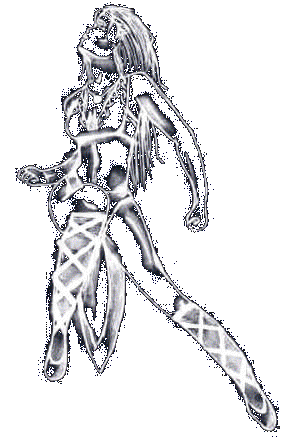Zom·bie also zom·bi (z¼m"b) n., pl. zom·bies also zom·bis. 1. A snake god of voodoo cults in West Africa, Haiti, and the southern United States. 2.a. A supernatural power or spell that according to voodoo belief can enter into and reanimate a corpse. b. A corpse revived in this way. 3. One who looks or behaves like an automaton. 4. A tall mixed drink made of various rums, liqueur, and fruit juice.
(American Heritage Dictionary)

Zombis are dead bodies with no souls, created by the
black magic of voodoo sorcerers. Voodoo is a
religion which originated in Haiti where West African
slaves could not practice their religion openly and
were forced to adopt in public the practices of the
French Catholic settlers. Voodoo is still a popular
religion in Haiti and in cities where Haitians have immigrated, such as
New Orleans. Vodu is an African word meaning spirit or god. The
black magic of voodoo sorcerers allegedly consists of various poisons
which immobilize a person for days, as well as hallucinogens
administered upon revival. The result is a brain damaged creature used
by the sorcerers as slaves, viz., the zombis. The zombi is not to be
confused with the zombi astral, whose soul (ti-bon-ange) is
controlled by the sorcerer.
Robert Todd Carroll
(http://dcn.davis.ca.us/~btcarrol/skeptic/zombies.html)

The Band
Rod Argent, guitarist Paul Atkinson, and drummer Hugh Grundy met
at St. Albans school in 1961 and began experimenting musically.
They brought on bassist Paul Arnold, who introduced the others to
the talented singer Colin Blunstone, a top student and athlete who
was headed for a secure job in an insurance firm before a more
glamorous destiny beckoned. The nascent group began their live
gigging in local venues doing the 50s rock and soul standards
common to bands everywhere at the time. Paul Arnold was replaced
by Chris White on bass. The band began playing shows around St. Albans in 1962, building up a
loyal following over the course of the next year
The Zombies turned
professional. In 1964, the group began recording. Decca staff
producer Ken Jones became infatuated with Argent's She's Not
There and pushed for it to be released as the first single .
The single was a worldwide smash in 1964 and
The Zombies were on a euphoric high. Everything was going right.
She's Not There even made it onto the popular TV show Jukebox
Jury, which happened to feature George Harrison on the panel that
week - and he loved the song. The tune made number 1 in America.
The next single, White's Leave Me Be, went over well in
performance, but failed to shake up the charts. The third single, Tell
Her No was a minor hit in Britain, and a Top 10 record in America.
The band came to America and did a package tour with artists like
Patti LaBelle and the Bluebells and Chuck Jackson. Riding
the British Invasion craze, they got a taste of the Beatlemania
experience.
The band stayed alive,
recording single after single that failed to break through with the
success of She's Not There or Tell Her No.
She's Coming Home and I Want You Back were unsuccessful in the
U.K., but both were minor hits in the U.S. in 1965. The band also
contributed songs to the soundtrack of the film Bunny Lake is
Missing and appeared briefly in it as well. Another musically
outstanding single, Whenever You're Ready also failed in Britain as
did its three successors. Disillusionment set in, with Rod and Chris
acting as cheerleaders to keep the enthusiasm going.
They decided to
break up, but not before recording a final album, Odessey and
Oracle, which was self-produced with the intention of being more
representive of the band's real sound, and was completed at Abbey
Road Studios late in 1967. According to interviews at the time, the
misspelling of "Odyssey" was deliberate and had all sorts of deep,
meaningful significance. Rod Argent has since admitted the more
prosaic reason: the cover artist misspelled "odyssey" and there
wasn't time to change it before the artwork was due at the printer, so
they let it go and made up a cover story likening the songs to
Shakespearian odes. (This anecdote courtesy of Andrew.)
CBS/Columbia was unwilling to release an album by a band that had
folded, but staff producer Al Kooper fought to get it issued, and it
finally came out in July, 1968. The first Odessy single, the
marvellous Care of Cell 44 failed to sell. So did the next single and
yet another. Almost as an afterthought, Time of the Season was
finally released as a single - a last gasp. It did nothing, but one radio
station in America fell in love with it and kept playing. Ever so
slowly, it caught on, and then, overnight, it broke all over the country
- becaming a Top 5 smash in late 1968 and early 1969. CBS
clamored for more product, promoters began offering huge sums of
money for the band to re-group, but it had already been a year since
the break-up, and The Zombies declined. Rod Argent and Chris had
already begun work on the band Argent, and Colin Blunstone had
begun a solo career
The Zombies' three biggest hits are now rock standards, and She's
Not There has been covered by other artists such as Vanilla Fudge,
Santana, The UK Subs, and Colin Blunstone himself during his solo
career). The Zombies reunited in 1991 for an album called New
World that wasn't released in the U.S. Despite The Zombies powerful
influence on bands such as The Kinks, The Left Banke, Procol
Harum and countless others, they have gone down as among the
most underrated groups in rock history.
SOURCES: http://members.aol.com/bocad/zom.htm